Outline of TNFD Response
The Nisshinbo Group believes that it is important to capture business opportunities and respond appropriately to the potential risks arising from nature-related issues. Therefore, starting in FY2024, the Nisshinbo Group will conduct risk assessments in accordance with the recommendations of the Task Force on Nature-related Financial Disclosures (TNFD).
The Nisshinbo Group plans to conduct analyses and evaluations of nature-related issues by systematically expanding the scope of analyses by conducting scenario assessments with the aim of enhancing the level of analyses. In addition, the Group plans to consider countermeasures for the nature-related risks identified in the current analysis, as well as additional targets and management indicators.
Through risk assessments based on the TNFD, the Group will identify the potential risks and opportunities posed by nature-related issues for the Group in the future and use this information in the formulation of business strategies to develop more flexible and robust strategies and enhance resilience to future risks.
TNFD Disclosure Item
Governance
As shown in the diagram below, the Nisshinbo Group established and operates a framework for appropriately responding to risks and opportunities related to nature. The Nisshinbo Group strives to turn risks into opportunities for sustainable growth by continuously monitoring and analyzing changes in the business environment. Under the corporate philosophy of "Change and Challenge! For the creation of the future of Earth and People," the Nisshinbo Group provides solutions to social issues and contributes to society, thereby creating new growth opportunities. In addition, responsibility for nature-related issues lies with the Board of Management, which consists of the President and executive officers. This committee discusses responses to nature-related issues and supervises the progress of goals. The details are reported to the Board of Directors as appropriate.
Governance Structure
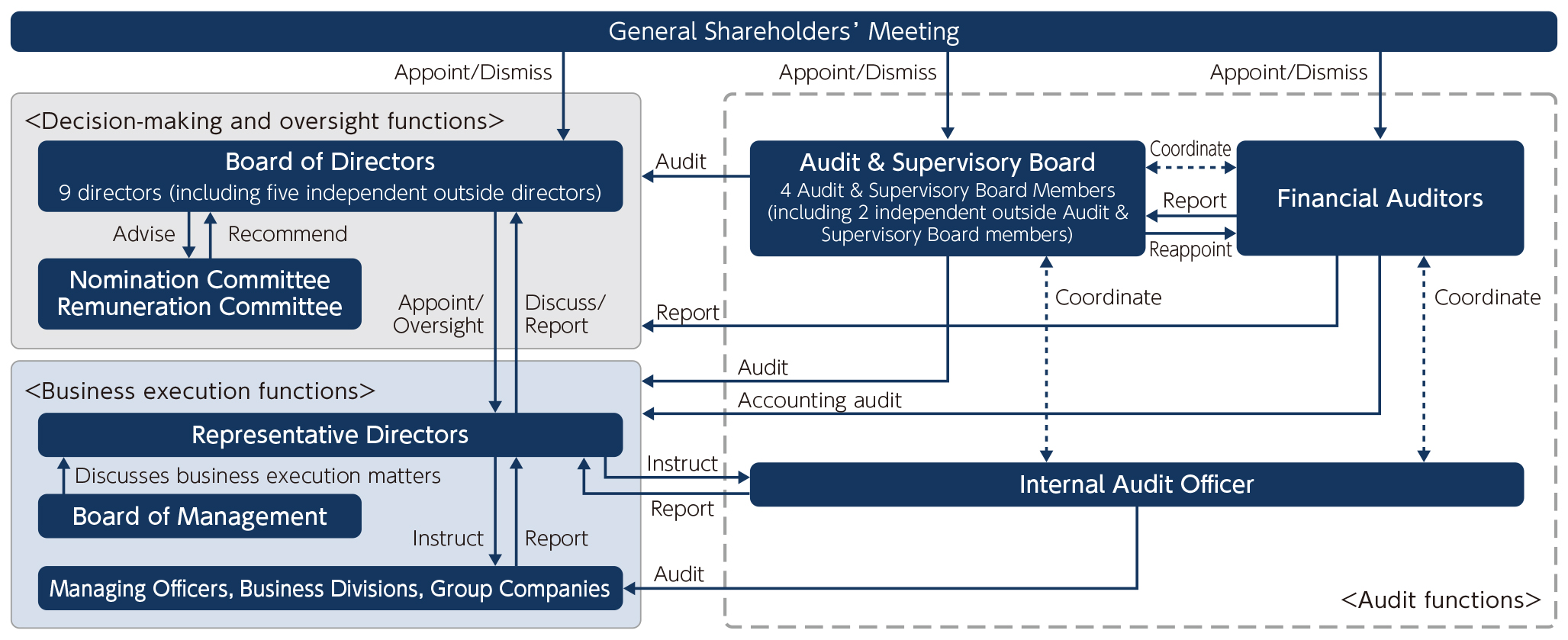
Risk and Impact Management
The Nisshinbo Group identified its dependencies on and impacts of key nature-related issues, as well as associated risks, and then conducted an analysis in the following steps for six businesses—Wireless and Communications, Micro Devices, Automobile Brakes, Precision Instruments, Chemicals, and Textiles—starting in FY2024.
As the first step in assessing natural risks, the Nisshinbo Group evaluated the dependence on and impact of the business on nature using the nature risk assessment tool ENCORE*. Next, the Nisshinbo Group selected the raw materials to be analyzed and conducted a risk survey and assessment of the entire value chain related to the business. Based on the results of this assessment, the Nisshinbo Group identified key issues related to natural risks. Nisshinbo analyzed areas surrounding its manufacturing sites and upstream in the corporate value chain where there are potential risks related to the identified key issues. For details on the analysis of areas where there are potential risks, please refer to the "Strategy" section.
* ENCORE: A tool developed by the international financial industry association NCFA and the United Nations Environment Programme World Conservation Monitoring Centre (UNEP-WCSC) to enable the results of the various existing tools related to nature-related risks to be evaluated collectively.

Risk Management Structure
The Nisshinbo Group has established and operates a risk management system to appropriately respond to management risks of business and to minimize losses in the event of management risks. With regard to the risks and opportunities related to nature that the Group should be aware of, the Nisshinbo Group will primarily identify, analyze, and evaluate the risks in each business segment based on the "Risk Management Regulations." Each business segment director will prioritize the risks and assume the magnitude of impact on the business under future scenarios. The Corporate Strategy Center is responsible for the overall mapping of this data, which is then discussed in the Board of Management and the Board of Directors.
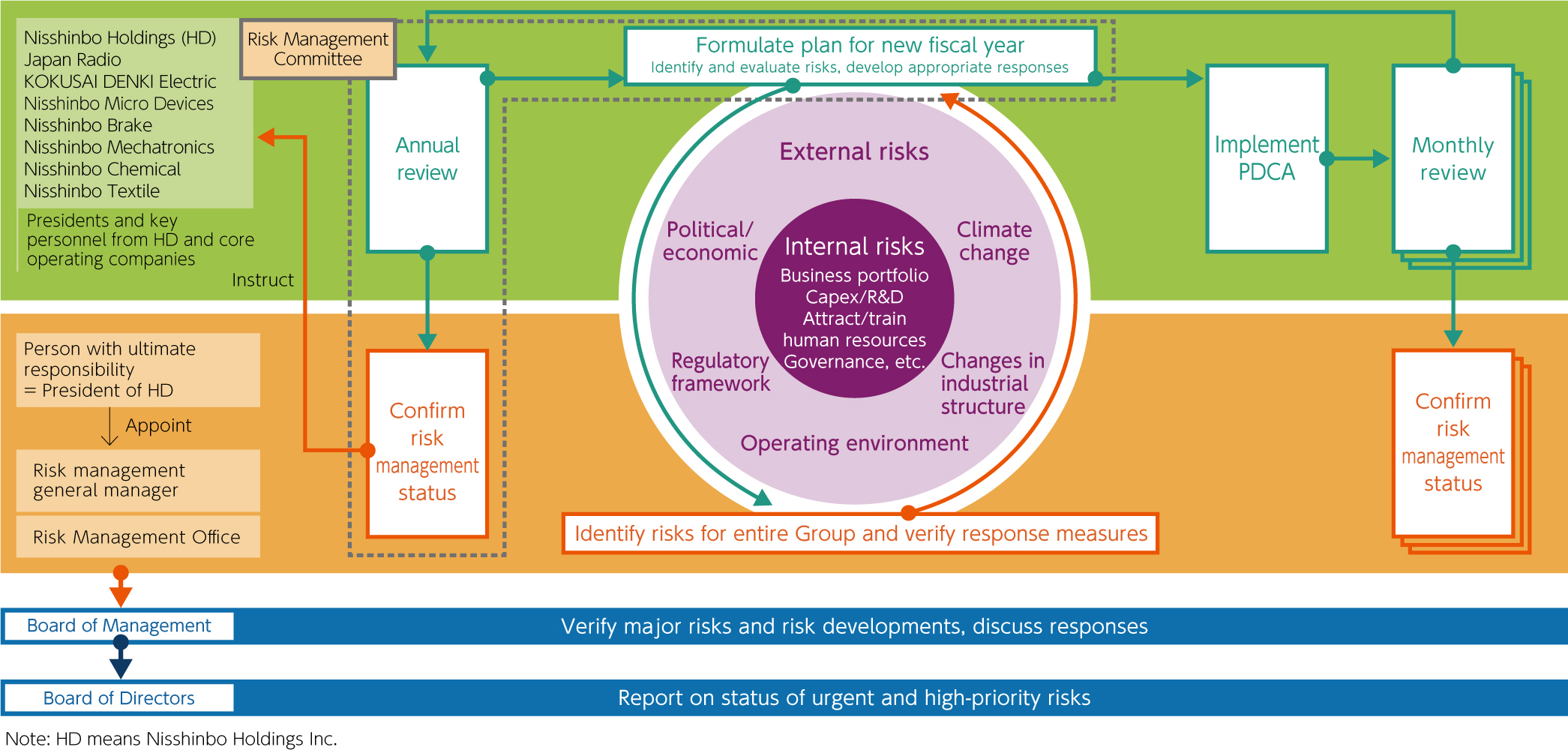
Risks and opportunities are assessed on a five-point scale based on the probability of occurrence and the degree of influence. Items whose products are more than constant are identified as important risks.

Taking into account the economic impact of identified risks, the Nisshinbo Group strives to respond by category to any of the four types of risk that can be avoided, mitigated, transferred, and held.
Risk Analysis Steps
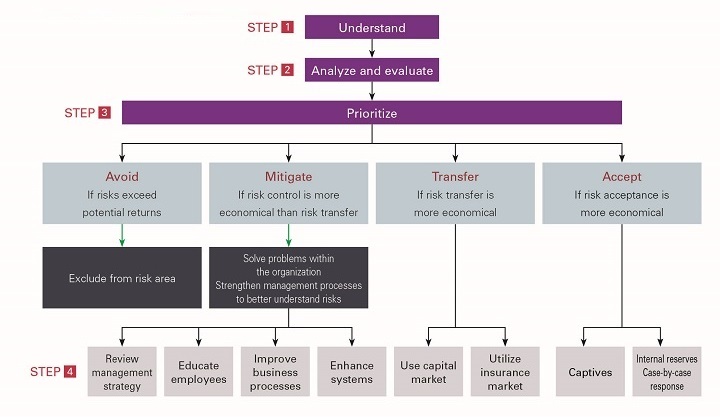
The details of the risks and opportunities that the Group perceives as having the potential to have an important impact on the linkage performance and response can be found on the "Risk Management" page.
Strategy
An Overview
The Nisshinbo Group operates a wide range of businesses, so the Group analyzed the important nature-related dependencies, impacts, risks, and opportunities in the value chains of the target businesses for FY2024, taking into account the scale of the businesses. The Nisshinbo Group also used nature risk assessment tools provided by the United Nations Environment Programme in conducting this analysis.
Furthermore, the TNFD framework recognizes indigenous peoples and local communities as important rights holders with regard to the natural environment and considers it important to take into account not only nature but also the human rights of rights holders.
The Nisshinbo Group established the Nisshinbo Group Human Rights Statement in August 2023. Nisshinbo sincerely recognizes the importance of its responsibility as a company to protect human rights. Under this policy, the Group will promote initiatives to respect human rights through human rights due diligence in accordance with international standards of the UN Guiding Principles on Business and Human Rights. The Nisshinbo Group is currently working to establish appropriate systems within each company and is taking steps to conduct appropriate human rights risk assessments for implementation of corrective measures.
1. Dependence on natural capital and understanding its impact
Referring to the TNFD classification, the Nisshinbo Group conducted an analysis of the potential dependencies and impacts within the value chain, including upstream and downstream operations, for each of the business segments. The nature risk assessment tool ENCORE was used for the analysis.
Heat map of our business and nature-related themes (dependencies)
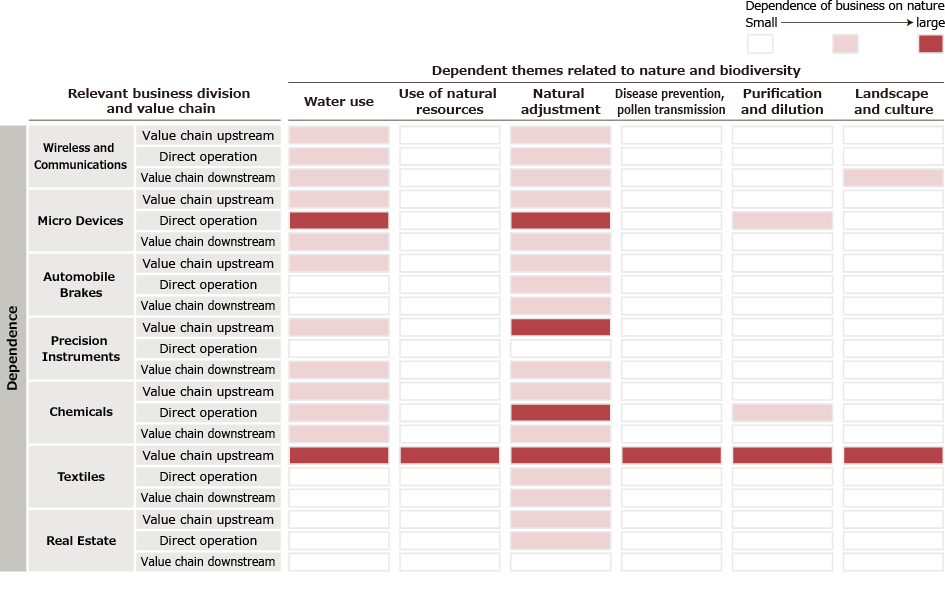
Heat map of our business and nature-related themes (Impact)

2. Risks that nature-related issues may affect business
Referring to the TNFD's classification of nature-related risks, the Nisshinbo Group examined nature-related risks and opportunities that could affect the Nisshinbo business. In conducting this examination, the Group investigated what risks and opportunities exist in each of the upstream, direct operations, and downstream stages of the value chain.
In this analysis, Nisshinbo focused on risk analysis as an initial step. Going forward, the Group will conduct scenario analyses based on the risks identified in this assessment to analyze the risks to Nisshinbo in greater detail and will also examine opportunities.
List of risks
|
|
|
|
|
|
|
|
|
|
|
|
|
|
|
|
| Risk type | Evaluation items | Risks | Value chain | |
|---|---|---|---|---|
| Major category | Small category | |||
| Transition risk |
Policy/regulation |
|
|
Upstream |
|
|
Direct operation | ||
| Reputation |
|
|
Upstream | |
|
|
Upstream | ||
|
|
Direct operation | ||
|
|
Downstream | ||
| Litigation |
|
|
Upstream | |
|
|
Direct operation | ||
| Physical risk |
Acute |
|
|
Direct operation |
|
|
Direct operation | ||
3. Important issues related to nature
Based on the results of surveys and analyses regarding dependencies and impacts, risks and opportunities, the Nisshinbo Group organized a materiality map using two axes: the vertical axis reflects the results of the assessment of dependencies and impacts using the ENCORE nature risk assessment tool, which indicates the concerns of external stakeholders; the horizontal axis reflects the results of the assessment of the degree of impact of risks on our business, expressed as the relationship with Nisshinbo Group's business. From the materiality map, Nisshinbo identified three issues related to nature as important issues for the Group: water, soil, and air pollution; ecosystem change; and water use.
The Nisshinbo Group identified strong links in terms of dependence, impact, and risk with regard to water, soil, and air pollution and ecosystem change in the procurement of raw materials used in the businesses that are the subject of the analysis. In addition, the Nisshinbo Group identified strong links between water use and semiconductor manufacturing in the Micro Devices business and cotton procurement in the Textiles business.
|
|
|
|
|
|
|
|
|
|
|
|
|
|
|
|
|
|
|
|
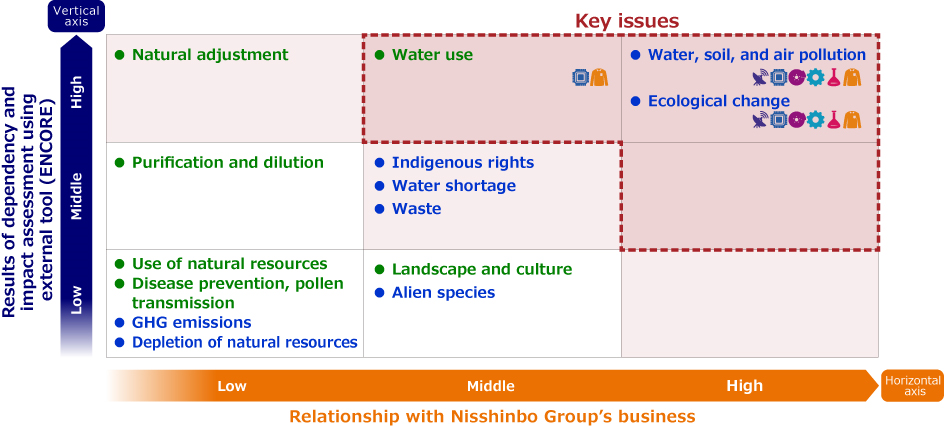
4. Analysis of areas with potential risk concerns
The Nisshinbo Group evaluated whether the direct operations of the Group and the activities of companies in the upstream value chain are located in sensitive areas with regard to specific important issues. With regard to direct operations, Nisshinbo analyzed the upstream value chain for 68 domestic and overseas sites of the Group, focusing on key mineral resources and cotton, and identified regions with potential risk concerns.
The Nisshinbo Group selects evaluation bases and tools according to the important issues and raw materials relevant to each value chain and identifies the potential risks in each region.
| VC | Related important issues | Related raw materials | Regional analysis methods |
|---|---|---|---|
| Upstream | Water, soil, and air pollution* | Major minerals |
|
| Upstream | Water, soil, and air pollution* | Crop (cotton) |
|
| Upstream | Ecological change | Major minerals |
|
| Upstream | Ecological change | Crop (cotton) |
|
| Upstream | Water use | Crop (cotton) |
|
| Direct operation | Water, soil, and air pollution* | All |
|
| Direct operation | Water uses | All |
|
* In manufacturing, direct operations (factories, research laboratories, etc.), mining of mineral resources upstream in the value chain and cultivation of agricultural products have a particularly significant impact on water pollution. Therefore, an analysis of priority areas should focus on water pollution.
Image of tools used
Aqueduct (water risk assessment tool): Image showing water stress
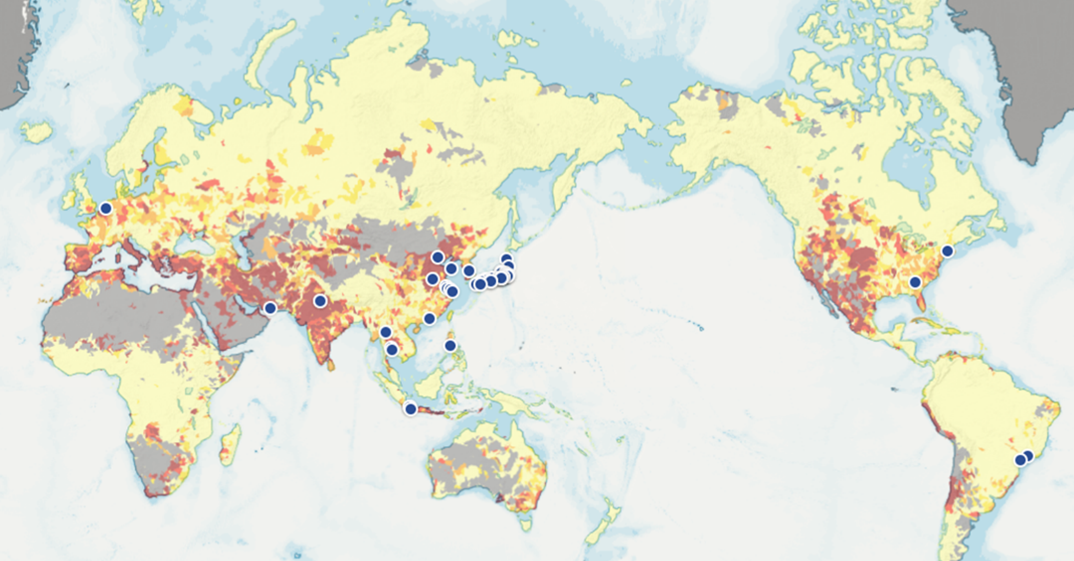
WWF Water Risk Filter (water risk assessment tool): Image showing water quality
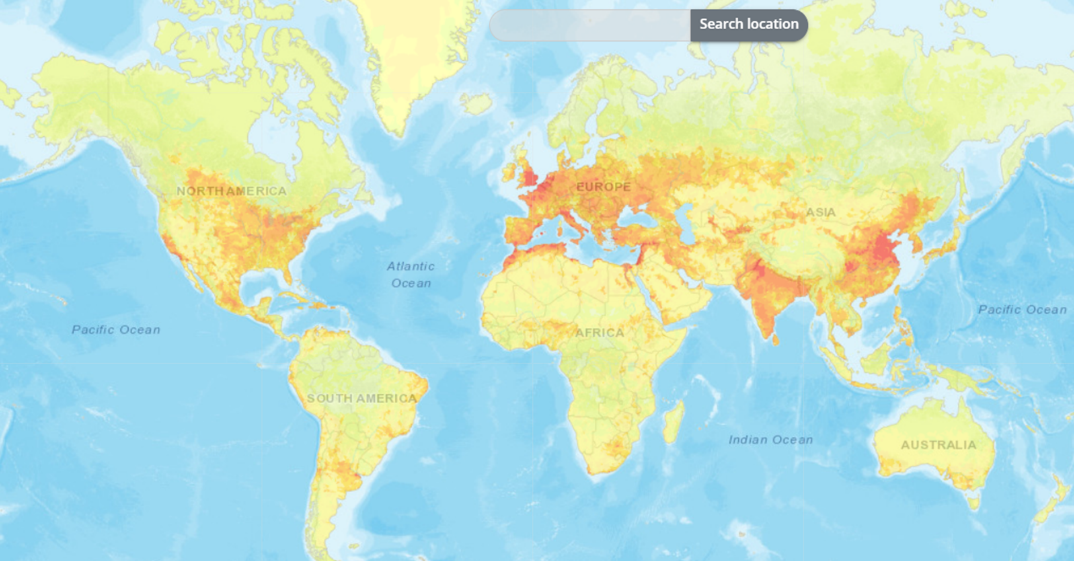
IBAT (biodiversity risk assessment tool): Display image of KBA (Key Biodiversity Area) and Nature Reserve
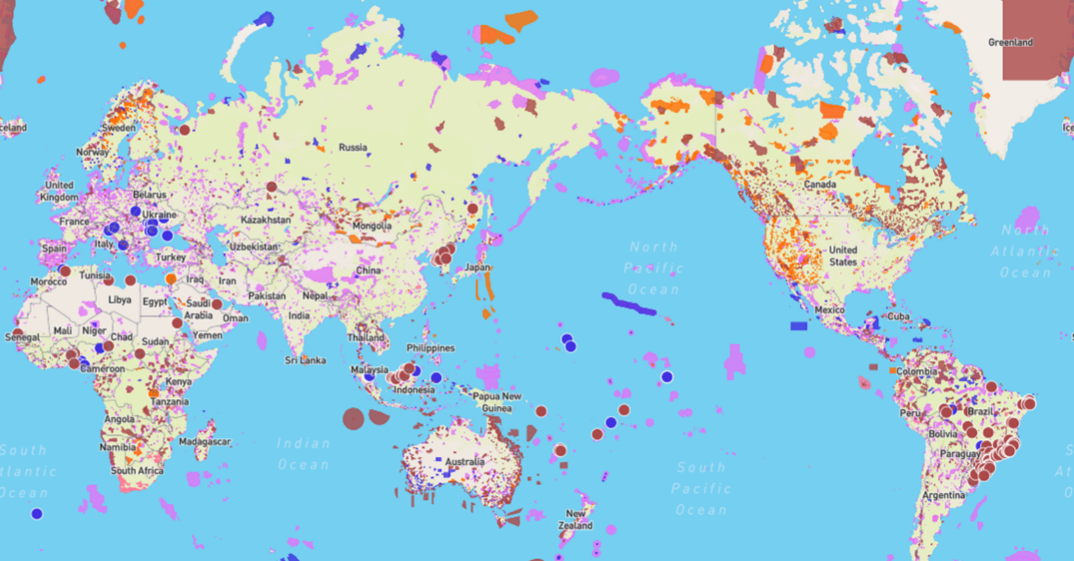
Analysis Results (Upstream Value Chain)
In the procurement of raw materials in the upstream value chain, the Nisshinbo Group conducted an analysis that focused on major mineral resources and cotton.
For major mineral resources, the Nisshinbo Group estimated resource-supplying countries and major mines (including smelters for water pollution) in the upstream value chain by using estimates from trade statistics in some cases and analyzed the ecosystem modification and water pollution of countries supplying the resources. As a result, concerns about the potential risks of both ecosystem modification and water pollution were identified in regions of China, Australia, Canada, Brazil, Guinea, and Sweden, while concerns about the potential risk of ecosystem modification were identified in regions of India, Indonesia, and Jamaica.
Among the mineral resources, gold is mined on a small scale in scattered locations in some of the producing countries. In such cases, an analysis is conducted of the procurement source at the country level. With regard to gold, the potential risks of ecosystem alteration and water pollution have been identified in parts of China, Russia, Ghana, Kazakhstan, and Colombia. In addition, concerns have been identified regarding the potential risks of ecosystem modification and water pollution at mines in Australia and Canada. Furthermore, concerns have been identified regarding the potential risks of ecosystem modification at mines in Mexico.
With regard to cotton, the potential risks related to ecosystem alteration, water pollution, and water use associated with cultivation have been identified in certain regions of several states in the three main sourcing countries (the United States, Brazil, and Australia). These regions include parts of California and Tennessee in the United States, parts of Queensland in Australia, and the states of Mato Grosso, Bahia, and Goiás in Brazil.
Analysis results (direct operation)
The Nisshinbo Group identified 68 domestic and overseas direct operating sites that pose potential risks in terms of water pollution and water use.
Potential risks related to water pollution have been identified at two sites in East Asia, while potential risks related to water use have been identified at 16 sites mainly in East Asia and Southeast Asia.
Metrics and Targets
Metrics
The Nisshinbo Group aims to capture nature-related business opportunities and reduce the potential risks. To reduce nature-related risks, the Group established indicators for GHG emissions, emissions of air pollutants other than GHG, water usage, and biodiversity conservation activities and now promotes measures to address nature-related issues. Going forward, the Nisshinbo Group will prepare to disclose indicators based on the TNFD in light of the results of an analysis of nature-related issues.
Targets
The Nisshinbo Group established that providing customers with eco-friendly products and services to create a safer and more secure society with integrity is one of its values, and this target defines the value and stance provided in order to realize the corporate philosophy. In addition, Nisshinbo established "Awareness and Concern towards our Environmental Impact" as one of its Business Conduct Guidelines. In order to deepen the awareness of biodiversity conservation and promote biodiversity conservation activities, the Nisshinbo Group set GHG emissions reduction, water consumption reduction, and strengthening of biodiversity conservation activities as environmental targets and key performance indicators (KPIs) for the Group, and Nisshinbo is implementing measures in a planned manner.
Based on the activities and results of the 5th Sustainability Promotion Plan, which targets 2024 as the target year, the Nisshinbo Group revised its targets and KPIs and launched activities for the 6th Sustainability Promotion Plan, which targets 2027 as the target year, starting in FY2025.
For an overview of the "Sustainability Promotion Plan", please refer to "Sustainability Promotion Plan and KPIs."
Please refer to the "Material Balance" page for information on Nisshinbo Group's business activities and environmental impact.

